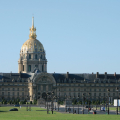HÔTEL NATIONAL DES INVALIDES
A hotel housing several visitor facilities, including museums, churches, and a hospital for wounded soldiers.
Although the Hôtel National des Invalides houses Napoleon's tomb and several visitor attractions (Musée des Plans-Reliefs, Musée de l'Ordre de la Libération, etc.), as well as churches open to the public, it has retained its original function as a hospital-hospice for wounded soldiers, dating back to the 17th century. The first hospice was founded in 1604 by King Henri IV, to house over-aged soldiers and war wounded. Named the "Maison royale de la Charité chrétienne", it was located on rue de l'Oursine in the present-day 5th arrondissement of Paris. After a few years, however, it fell into decline under Marie de Médicis. Although Cardinal Richelieu took up the torch in 1634, the initiative was short-lived, as a direct consequence of the Thirty Years' War. It was not until the reign of Louis XIV, assisted by the Marquis de Louvois (1639-1691), that the decision was taken to build a new Hôtel Royal des Invalides for soldiers unfit to defend the crown - in the words of a royal edict, "old men of no means who have served in its armies. So that those who have exposed their lives and shed their blood in defense of the monarchy... may spend the rest of their days in peace". The project was financed by taxes levied on abbeys and priories. Within these walls, doctors, surgeons and apothecaries, directly appointed by the monarch, enjoyed privileges equal to those of members of the court. So much for the project's staying power! The hotel was built in 1671, outside the city, on a plot of land in the former Plaine de Grenelle, between the Faubourg Saint-Germain and the village of Gros-Caillou. The buildings (lodgings, infirmary, refectories, etc.) formed a vast rectangle measuring approximately 450 m x 390 m. In 1676, when it was commissioned, the hotel accommodated almost 6,000 men. However, the work was not completed until 1706, just a few years before the monarch's death. It took thirty years to complete this major project, five of them under the direction of Liberal Bruant (1636-1697) and the rest by Jules-Hardouin Mansart (1646-1708), architect of the famous Dome. A masterpiece of 17th century architecture, the monumental complex as we know it today is organized around a vast courtyard of honor accessible from the main porch, which opens onto the famous esplanade. After passing through the entrance gate flanked by two guardhouses (small pavilions) and a moat 6 m wide and 3 m deep, overlooked by a series of impressive cannons, the 210 m long monumental facade is richly decorated with motifs - all related to martial activities: weapons, trophies, badges, breastplates... - whose central porch is framed by two statues, one of Mars, the other of Minerva, both divinities linked to war. Above, a large half-moon tympanum portrays Louis XIV in antique style, i.e. on horseback and dressed in Roman costume. At his feet are the personifications of Prudence, with an open book, and Justice, with a sword and scales. It should be noted that these sculptures, which had been damaged, were reproduced in the 19th century in the same style as the originals. The Cour d'Honneur may look like a perfect square to the naked eye, but it's a clever play on architecture and optics, measuring 102 m x 64 m. Its open galleries, with their apparent two storeys, are just as illusionary, although in reality they have four. Here, the décor features warrior motifs combining symbolic figures and trophies of arms. But once you're there, you'll have to find a sculpted wolf under a bull's eye, an allusion to the Marquis de Louvois... This courtyard is also the gateway to the various exhibition areas (Charles-de-Gaulle historial, unusual cabinets, military history collections...). You'll also notice the recurring sundials that adorn the walls, an allusion to the Sun King. In line with the main entrance, Saint-Louis-des-Invalides ("Soldiers' Church"), a place of worship dedicated to the Holy Trinity, was built in 1676 by Jules Hardouin-Mansart to designs by Liberal Bruant. In addition to its classical architecture, it features flags and banners taken from the enemy during various battles.But this building and the famous dome, where Napoleon's tomb lies, are one and the same, separated only by a glass roof. The Saint-Louis church corresponds to the nave, and the dome to the choir. Nevertheless, the latter, built between 1676 and 1706 by Jules Hardouin-Mansart, is the building's masterpiece. While the gold-leafed dome reaches 113 m in height, the interior is just as spectacular, as is the masterly façade. Napoleon's tomb is equally monumental. Made of red quartzite and green granite, it measures almost 4 m x 2 m. Twelve statues of Victories sculpted by Pradier surround it, while the floor features a polychrome mosaic commemorating the Emperor's major battles. Please note that access to the site will be slightly modified during the renovation work.
Members' reviews on HÔTEL NATIONAL DES INVALIDES










Les armes de collection sont magnifiques et intéresseront aussi bien les passionnés que les amateurs ou les curieux